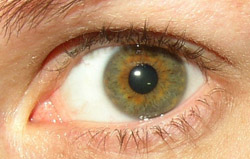Think about the building where you live. If it's a house or an apartment building, it's made up of water pipes, a roof, different rooms, and thousands of wooden boards. On your street there are probably many different buildings and each building is very, very complicated. For people to be able to live inside, all the thousands of different parts have to work and fit together. To build something with so many parts, architects have to draw every single part. They need to think about every electrical plug, toilet, and wall. The architects then give their drawings to people who build the house. These drawings are the instructions that show them what to build. Since there are so many different parts to put together, every building needs its own instructions.

Even a building as simple as this one needs a lot of instructions. Think about a huge apartment building!
Just like buildings, all people are built differently too. For instance, the people in your class might all have different colors of eyes, hair, and skin. People can change what they look like somewhat by cutting their hair or wearing different clothes. You can decide what some parts of you look like on the outside, but you can't decide how you are built. The parts of you that you cannot change are in your genes.
Genes are the instructions for your body and they are inside of every one of your cells. They are found in every other living thing on earth too, and are the instructions for how to make each of those things. Your genes tell your cells what to do. They tell your body how to grow, make you look a certain way, and even decide what your personality will be like.

Palm trees in Los Angeles, CA.
Régis Lachaume, Public domain, via Wikimedia Commons
Genes give you characteristics that can make you look the same as other people or very different from them. Your genes might give you brown eyes, black hair, and make you 5 feet 4 inches tall. All other living things also have characteristics that came from their genes. A palm tree might be tall, brown, skinny, and have green leaves at the top. Each of those is a characteristic of that palm tree. Another name for a characteristic that we use in science is trait. A
trait is any part of a living thing that was determined by its genes, by its environment, or by both.
There are three different reasons why the person and the palm tree are the way they are:
1. Their genes make them that way
(Your genes make your eyes brown, blue, or green)
2. Their environment makes them that way
(You are around people who smoke and you get cancer, or you are not around people who smoke and you don't get cancer)
3. Their genes and their environment made them that way
(Your genes tell your cells to grow tall, but you don't eat healthy food and you grow up to be 5 feet 8 inches instead of 6 feet tall)
You might have some of the same traits as your parents. The parts of you that you share with your parents were either passed down in their genes to you, or come from the environment where you both live. Every child gets half of each of their parent's genes.
Heredity is the name for when genes are passed from parents to children. It is one of the reasons why you look like both of your parents.

Hazel eyes are a trait that is passed down in genes.
Tlf333 at English Wikipedia, Public domain, via Wikimedia Commons
Genes are not the only things that make you and your parents look the same. You and your parents may also spend time in the same environments or different ones, and that will also change how you look. If you and your parents have a gene for dark skin, and you spend more time than them outside, your skin will be darker than theirs. If you spend time inside and your parents spend most of the day outside, they will have darker skin than you. The environment is very important in how the same trait looks on different people.
In humans, each child gets half of each of their parents' genes. This means that every child will get half of their father's genes and half of their mother's genes. No child is exactly the same as either of their parents, because they only have half of each parents' genes. This also means that every single person is different or varied.
Variation means that there are differences between things. If you look at the chairs in your classroom, they might all look the same. There is no variation in the chairs. Now look at what the students in your class use to write. Some may use lead pencils, while others use pens. All of these might be different sizes or colors. There is variation in the colors, types, and sizes of what your classmates use to write with in your class. In science we use variation to describe differences between organisms.

There is no variation between the black chairs in this picture, but there is variation between all the chairs that we can see. Some are red or black, and they are built differently.
Ib Rasmussen, Public domain, via Wikimedia Commons